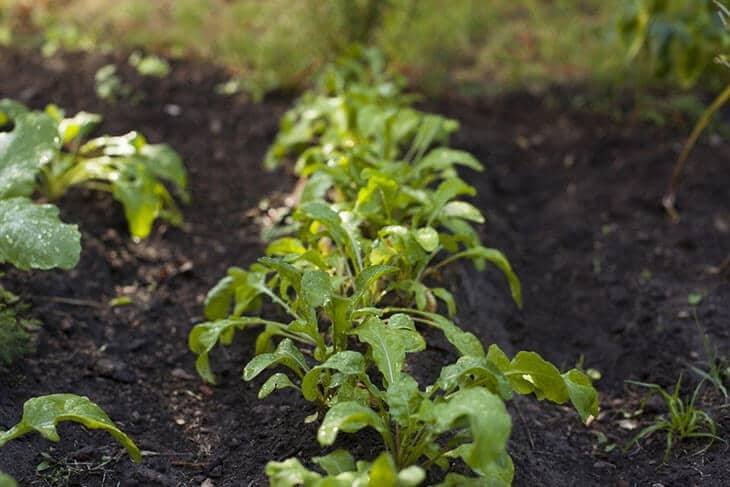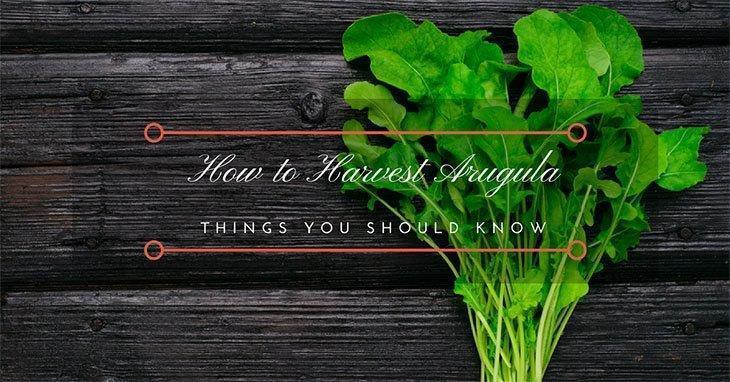If it’s your first time growing arugula in your garden, you’re probably wondering, “How to harvest arugula?” Don’t worry because there are actually three ways to do it, but don’t worry about having to learn all three because I will guide you step by step on learning the best way to harvest arugula from your garden.

A wicker basket with freshly harvested Arugula leaves
More...
When your arugula starts to grow, you will easily recognize it because it grows around 20 cm, and the arugula flowering is a noticeable white, tiny one. You will also notice that its leaves are lobes, and there will be around 10 lobes per stem.
Did you know that even if arugula is known to be grown by fellow gardeners, they actually are considered a wild species around the world? Sometimes they get mistaken as a type of lettuce, but little did they know arugula is more than that and is packed with different benefits.
Arugula can greatly increase your oxygen radical absorbance capacity it works like a detoxifier in your body that gets rid of disease-causing free radicals. Since arugula is packed with antioxidants, it also boosts your immune system.
But that’s not all! Because arugula is packed with vitamin A, people who regularly eat arugula stated that it has made their bones, teeth, and even their eyes better than ever before. It also has vitamin K, which is an anti-inflammatory and at the same time promotes bone formation.
To sum it up, growing arugula in your garden is a very good choice; you get a lot of benefits from it, and those you read from above aren’t just it, because those are only part of the many things you can benefit from harvesting your own arugula from your own garden. So what should you have ready when you decide it’s time to harvest them?
Things You Should Have To Harvest Arugula
How To Harvest Arugula
So how do we harvest arugula? Doing it the right way is very important to ensure that the plant will grow you another supply of greens. Harvesting arugula is very easy, actually.
How To Harvest Arugula
When it comes to harvesting arugula, it’s very easy, and there are only 2 steps to make. You have to start by identifying if your plant is ready for harvesting. Only the largest leaves should be harvested.
Remember to cut as many as you need only because the more you cut, the more it would produce. That could cause bolting.

A picture of an Arugula planted in soil
Cut What You Need

A man harvesting Arugula with a scissors
The second step is to cut. Yes, that's all. But remember to try to cut around it as much as possible and not in it. That way you won’t make your plant feel naked or have bald spots. Another thing is, remember to not cut too deep because your plant might die or it might not produce leaves in that area anymore.
Yes, that’s everything on how to cut Arugula from the garden, all you need to do is identify the long ones and cut them, the only thing you have to make sure of is that you don’t cut off the whole plant, that’s unless you don’t want it to grow back.
Here’s a video of how to harvest arugula from your garden.
What To Do When Arugula Bolts
There are varieties that bolt slower, but regularly some factors make Arugula bolt sooner than lettuces. There are ways to prevent it, though. If your Arugula is bolting, you can try picking any of its flower buds, some people say that usually works but for some it works for a while then they get the hang of it and start bolting again.
So what else could you do? You could try cutting them more often. But if that still doesn’t work, try to sow seed around every 3 weeks. At least you wouldn’t be stuck with one that’s bolting.
Ways To Enjoy Your Harvested Arugula
01. Salads
Arugula makes an amazing salad whether you mix it with other greens or you have it on its own. It tastes good with vinaigrette, but it is often preferred to be paired with a sweeter balsamic because of the balance it creates with the peppery taste.
02. On Pizza
Arugula makes an amazing salad whether you mix it with other greens or you have it on its own. It tastes good with vinaigrette, but it is often preferred to be paired with a sweeter balsamic because of the balance it creates with the peppery taste.
03. Toss Into Soups
If you want to add some greens to your soup, Arugula would be a great choice. Just toss in a handful after you turn the flame off and you’re good to go.
04. Toss Into Pasta
Just like how you do it with soups, just toss in a handful into your pasta while dressing it with sauce or add it to the sauce when you turn off the flame. Just remember not to cook the Arugula.
05. With Eggs
Just Saute the Arugula with either olive oil or butter until it wilts, then add in the beaten eggs. Season to taste and you’re done! Another way is to turn it into a bed for your sunny side up.
06. Sandwiches
Looking for a bit of spice for your sandwich? Arugula could be a tasty substitute for lettuce. Did you know that it’s the classic green for hot sandwiches, namely Panini?
07. Roasted Vegetables
This one would be the easiest, just toss your freshly roasted vegetables with Arugula before you serve it. The best match would be some roasted potatoes, beets, squash, and even some baby carrots.
08. Pesto
Out of basil? Or just want to try something new? Arugula would be a good substitute for basil and a good way to use your surplus of Arugula.
09. Lasagna
Instead of using spinach, try using arugula, or try a combination of both to give some spice and crunch to your lasagna, that way it’ll be tender but with a little more bite. Something different but definitely tasty.
A Little Bit Of Everything About Arugula In Your Garden
Where Did It Come From
Arugula most of the time gets overshadowed by some of its famous counterparts most commonly known as the broccoli and kale which are calciferous vegetables. It has tender leaves that are actually bite size.
This vegetable naturally has a somewhat tangy and spicy flavor that’s very distinguishable. This vegetable, Arugula is commonly known for food, but what a lot doesn’t know is that it came from a long history before that.
If you will base it on several historical accounts, they show that this vegetable has been first planted where it's popularly incorporated into salads, the Mediterranean, and European regions. Did you know that this plant has appeared in the Bible several times? Yes, it has. And that’s one show-tale that it has been around for a long time.
It was mentioned in the Old Testament, specifically the Book of Kings, it was then named Oroth, but as historians did their research it was believed that it was an arugula. From Talmud and Mishna’s Jewish holy writing, arugula was once again mentioned. And a Jewish historian also said that it was arugula. And mind you, this was all since the first century AD.
Back in the days, ancient Romans planted arugula for different purposes. They used it as an aphrodisiac; it was then called eruca. An elder that’s also a soldier and lawyer also researched Arugula.
In fact, he has an encyclopedic masterwork that talked about different ways to use arugula during his days. And after going through his works, it was found that arugula wasn’t just an aphrodisiac but a natural anesthetic as well. As we can see, it seems like Arugula is actually more than what we see it as today.
Different Varieties
There are 3 different varieties of arugula; one is the Eruca Selvatica. The difference of this with the others is that it takes more time to sprout. And compared to its counterparts, its leaves are thinner and darker in color.
Another one is Eruca Sativa, this one is the more traditional one. Believe me when I say this type of arugula could germinate in just 3 days. That’s the reason why impatient gardeners love them. It has rounder leaves compared to the others.
And the last one is the Italian arugula; this is the most common one today. It has long strap-like leaves and can survive even under heat. That’s the reason why it’s typically grown in places with hot climates.
Best Way To Plant Arugula
There wouldn’t be any problem if you lived in a place where the climate is cold. This plant could definitely resist cold temperatures. If you’re starting from scratch, the best way is to start with seeds.
The best time would be in spring or in the later part of summer you could start sowing them. Plant in an area where sunlight is abundant, but if you’re in a place where it’s always hot put it in a place where there’s shade. Especially in its first weeks.
Make sure to sow it at a depth of ¼ inch and make sure that there’s at least an inch space between each plant. But as it grows, the space should also increase by around 6 inches.
Your plant would usually grow after four weeks, but everything will more likely depend on other factors like the effort you put in to make sure your plant isn’t just surviving but thriving as well.
Care And Maintenance
Basically, an Arugula is an easy plant to take care of, it doesn’t need much attention, unlike the others. But there are important factors to remember, the soil should be in a very healthy condition.
What we’re expecting here is a pH level of 6–6.5. Arugula could grow in a well-drained soil but you’d have to remember to water it more frequently than you would if it isn’t well drained. If you’re aiming for your plant to be healthy, of course, you are.
Then make sure to fertilize depending on what your plant needs. Let’s say there are yellow leaves then go for one that is a fish emulsion. As you see the needy-ness of the Arugula would depend on how its condition is.
Explore more: Top 5 best grow lights 2019 (Proven Tips)
Conclusion
So there goes every little bit of information you need to know about how to harvest Arugula. In this article we also added a “How to harvest Arugula Video”, to make sure you know how to cut Arugula from your garden.
Remember that planting Arugula is very easy to do and would be giving you more benefits than you know when you have it regularly. Before you start harvesting, keep in mind that you shouldn’t be cutting more than you need because that could lead to your plant bolting.
But if it’s too late and your plant has started to bolt, don’t worry because there are still some things you could do about it. Just keep everything we shared with you in mind today and you’re definitely good to go.
So, what do you think about this article? Did we help you know how to harvest Arugula? Did we help you gain more knowledge about Arugula? Were you aware of its benefits before reading this article? Share whatever you think about this article down in the comment section.
And if you liked this article, and if it has helped you, feel free to share it and help more people learn more about harvesting and other things about Arugula! Have a great day!
Like this post?
Let us know what you think by leaving a comment below. Share it with your friends, too!
Discover More:

